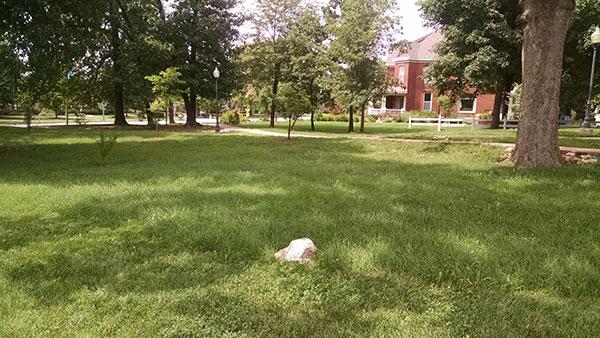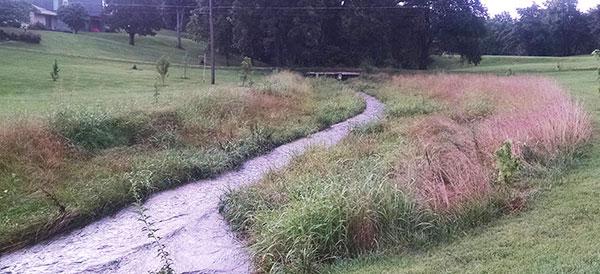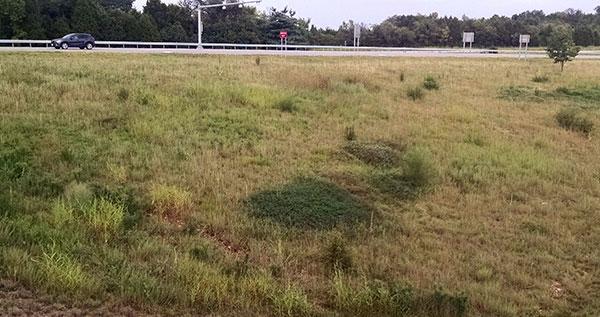Rethinking Restoration
Here at Drury University we have several tracts of land that we want to restore. When I say restore some may say restore to what? Many people conjure up images of native meadows or woodlands. Our campus project has the meadow option in mind. In our work, restore also generally means to return an area to some previous state of vegetation, and to repopulate with some various native plant material. Restoration can be carried out for several reasons and is widely recognized as a viable option in grounds management. That is to say, stakeholders in the specific patch usually won't freak out when restoration is considered.
Restoration Benefits
There are several benefits that can be realized via a restoration project. First, restoration can be supportive of, and integrated into, sustainability efforts. By reducing the maintenance requirements of an area, you save resources. Restoration can add to the aesthetics of an area by contrasting other areas, introducing rotation of bloom or textures, and the inherent beauty of "amber waves of grain". Function of the area can be improved. Meadows can also play an important role in ecology by supporting pollinators, songbirds, catching rainwater, and simply by increasing biomass. There are also other benefits that may be site specific to be determined by the participants.
Some Considerations
Restoration is not a magic bullet. Sometimes a grounds manager will consider restoration but factors align to eliminate this as an option. Typical installation practice involves eradicating existing vegetation, which might create an erosion problem. Establishment is, at best, a several-season process, during which the site can look different than its ultimate desired appearance. The blend of seed for desirable plant mix is critical, but many excellent sources and mixes are available. Proximity to high value areas generally discourage restoration projects. Proximity to residential areas can also have an impact. Both of these can originate from concerns of aesthetics, security, or even wildlife encroachment. Local conservation or Extension services, as well as professional colleagues, can be a great source of technical advice, which can increase the likelihood of a successful restoration.

Attempting to introduce meadow appearance too close to high value area (DU President's House)
Start Where You Are
As previously stated, the usual restoration process begins with eradication of existing vegetation. Here is where I think a different, more gradual approach can be incorporated. I suggest simply to begin managing the area as a meadow while you oversee a transition from the previous state to a restored state. In particular areas, simply by decreasing mowing frequency, raising mowing height, or stopping altogether, a meadow appearance can quickly be created. I suggest that while many people with some plant/nature knowledge will know that it is not truly a meadow yet, the average person will still take in the area as a meadow. Many areas stay in a turf configuration due to constant management, the discontinuance of which will allow a natural succession to begin to restore the area to something else. This approach is less disruptive and uses less resources also.

Mowing adjustments allow for restorative appearance and riparian protection.
Inescapable Environmental Influences
While for some return to native or predevelopment condition is the objective, I suggest a less predetermined goal. In any area, there are inescapable environmental influences that have for thousands of years determined what organisms survive in each region. Weather patterns are made up of temperature range, natural rainfall, prevailing winds, etc. The specific geology of an area is set in the bedrock, which unlike topsoil disturbance, does not change over time. Native organisms have evolved over millennia, in coexistence with everything in the area, not simply adaptable because of some few similarities. Certainly these influences fluctuate because of many factors (disturbance, development, exotics, etc.), but they create a broad, yet inescapable limit to what can inhabit an area when allowed to be the dominant determinant factors.
Incorporate Reasonable management practices
I am not suggesting simply to stop mowing and you will restore an area to exactly what you want. I am suggesting using low intensity management to influence what thrives in an area. Mowing/brushhogging height and frequency is a significant management tool. Another is overseeding the affected area with whatever seed blend you desire. As with turf, overseeding can change the plant mix in a stand in a desirable direction. Spot spraying to eliminate noxious invasives (Johnsongrass) is also very beneficial.
Lastly the consideration for controlled burn can be included although this may not be considered low intensity. I include public education in management. Some well-placed signs can explain the exact what and why of a restoration project, and helps prevent concerns about the changing landscape.

Minor cultural management could improve this area and create restored appearance
This should work/shifting expectations
When I look at these photos, I do not see neglect. I see a reasonable and appropriate management approach that can be utilized where appropriate. I also see an area in transition, but acceptable nonetheless. The underlying desire I have in suggesting this approach is to not have to go backwards to then go forward in restoring an area. I simply suggest starting where you are, defining where you want to go, and begin immediately moving there.



1 Comment
Recommended Comments